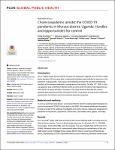Cholera epidemic amidst the COVID-19 pandemic in Moroto district, Uganda: Hurdles and opportunities for control
Date
2022Author
Orishaba, Philip
Opollo, Marc Sam
Nalwadda, Christine
Muruta, Allan
Makumbi, Issa
Kabali, Kenneth
Nakinsige, Anne
Lotee, Phillip
Okware, Samuel I.
Bwire, Godfrey
Metadata
Show full item recordAbstract
Introduction
On 21st March 2020, the first COVID-19 case was detected in Uganda and a COVID-19 pan demic declared. On the same date, a nationwide lockdown was instituted in response to the
pandemic. Subsequently, more cases were detected amongst the returning international
travelers as the disease continued to spread across the country. On May 14th, 2020, a chol era epidemic was confirmed in Moroto district at a time when the district had registered sev eral COVID-19 cases and was in lockdown. This study aimed to describe the cholera
epidemic and response activities during the COVID-19 pandemic as well as the hurdles and
opportunities for cholera control encountered during the response.
Materials and methods
In a cross-sectional study design, we reviewed Moroto district’s weekly epidemiological rec ords on cholera and COVID-19 from April to July 2020. We obtained additional information
through a review of the outbreak investigation and control reports. Data were analyzed and
presented in frequencies, proportions, attack rates, case fatality rates, graphs, and maps.
Results
As of June 28th, 2020, 458 cases presenting with severe diarrhea and/or vomiting were line
listed in Moroto district. The most affected age group was 15–30 years, 30.1% (138/458).
The females, 59.0% [270/458], were the majority. The Case Fatality Rate (CFR) was 0.4%
(2/458). Whereas home use of contaminated water following the vandalization of the only
clean water source in Natapar Kocuc village, Moroto district, could have elicited the epi demic, implementing COVID-19 preventive and control measures presented some hurdles and opportunities for cholera control. The significant hurdles were observing the COVID-19
control measures such as social distancing, wearing of masks, and limited time in the com munity due to the need to observe curfew rules starting at 6.00 pm. The opportunities from
COVID-19 measures complementary to cholera control measures included frequent hand
washing, travel restrictions within the district & surrounding areas, and closure of markets.
Conclusion
COVID-19 preventive and control measures such as social distancing, wearing of masks,
and curfew rules may be a hurdle to cholera control whereas frequent hand washing, travel
restrictions within the district & surrounding areas, and closure of markets may present
opportunities for cholera control. Other settings experiencing concurrent cholera and
COVID-19 outbreaks can borrow lessons from this study.
URI
https://doi.org/10.1371/journal. pgph.0000590http://ir.lirauni.ac.ug/xmlui/handle/123456789/734
Collections
- Research Articles [19]

